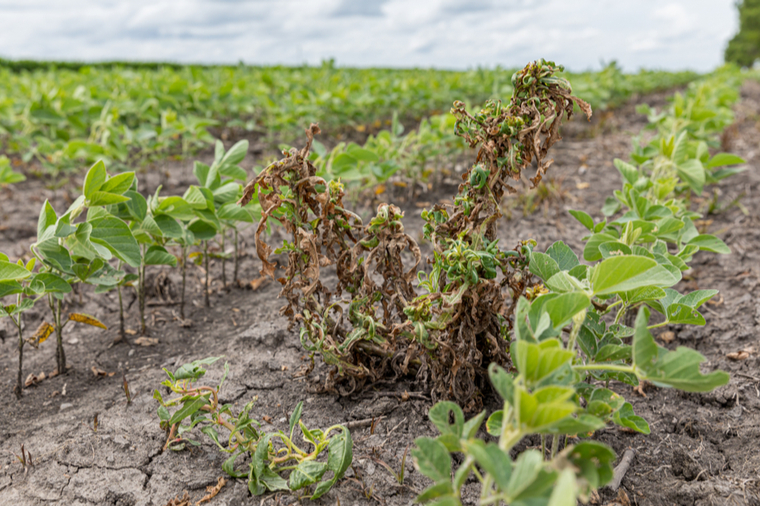Dicamba has been the subject of lawsuits across the country, including here in Missouri where landowners contend the herbicide, when used by neighboring growers, has blown onto their property, killing valuable non-resistant crops.
Dicamba is sprayed in a formulation that contains an amine, a chemical agent that is supposed to keep the herbicide in place, preventing it from going airborne. Ongoing reports of crop damage despite these measures have previously shown, however, that it may not be working as it should, particularly when the dicamba/amine formulation is sprayed with the most commonly used herbicide in the world, glyphosate, the main component of Roundup.
Washington University in St. Louis researchers in the lab of Kimberly Parker, assistant professor in the Department of Energy, Environmental & Chemical Engineering in the McKelvey School of Engineering, have proposed a mechanism that describes how dicamba volatility is controlled by amines.

The finding was published in October in Environmental Science & Technology.
The factors that result in dicamba volatilizing — becoming airborne — have been investigated before in scientific studies conducted on fields and in greenhouses where researchers measured how much dicamba transformed into a gas that could be measured in the air or by assessing damage to plants.
But there remained major gaps when it came to understanding the molecular processes at work, so Parker’s lab set out to fill them.
“We decided to approach it from a unique direction,” said lead author Stephen Sharkey, a PhD student in the Parker Lab. “We wanted to try to get into the chemistry behind the volatility process.”
He started with considering the interactions of molecules in the solid phase of the dicamba/amine formulation.
There are three amines that are typically used in commercial dicamba formulations. Sharkey considered those three commonly used amines as well as six others to get a better, more generally applicable understanding of their properties and their impacts on dicamba volatilization. How are the amines interacting with dicamba and can this information be used to discover why dicamba is still volatilizing?
Parker said that there are a couple of common assumptions about what is happening between amines and dicamba: the heavier amine acts like an anchor, thus weighing down the herbicide, or volatilization is determined by pH levels.
Sharkey’s research showed something different. In regard to the three most-used amines, he said, “the ones that work best have more hydrogen bonding functioning groups.” He went on to find the same results in the six additional amines.
The researchers also looked at how other molecules may impact these interactions. “We found glyphosate increased volatility in two of the three main amines,” Sharkey said. “One way dicamba products may be used is alongside glyphosate as a way of killing many different weeds,” including those resistant to glyphosate and/or those resistant to dicamba.
The research team believes it may be the case that glyphosate, which has lots of places where it can form hydrogen bonds, may be interfering with dicamba’s ability to form bonds with the amines. In essence, glyphosate may be driving a chemical wedge between the two by forming its own bonds to the dicamba or amine molecules.
None of the other potential factors they tested had as reliable or consistent an effect on volatility as the number of hydrogen bonding sites on the amine.
The team tested several different variables, including temperature, reducing the amine concentration relative to dicamba, amine acidity, amine vapor pressure, amine molecular weight, solution pH values and the presence of glyphosate.
“We showed those were not primary determinants,” Parker said. “Hydrogen bonding seemed to be the primary factor. If the amine has more hydrogen bonding functional groups, dicamba volatility is decreased compared to other amine formulations.”
Going forward, this better understanding of how dicamba and amines interact identifies a specific characteristic that can be modified to improve a formula’s ability to remain on a crop and away from surrounding fields. It also points to the benefits of studying herbicides in the lab in addition to the work done by other researchers in the field. That’s something Parker and her team have been doing and will continue to do.
As for next steps, Sharkey’s latest work is a look at how the introduction of more tolerant crops affect usage of herbicides. Parker said she’d like an expanded understanding of the effects of more complex chemistries on dicamba volatility.
“What about other chemicals on a leaf’s surface, for example?” she asked. “How might those further affect volatilization?”



